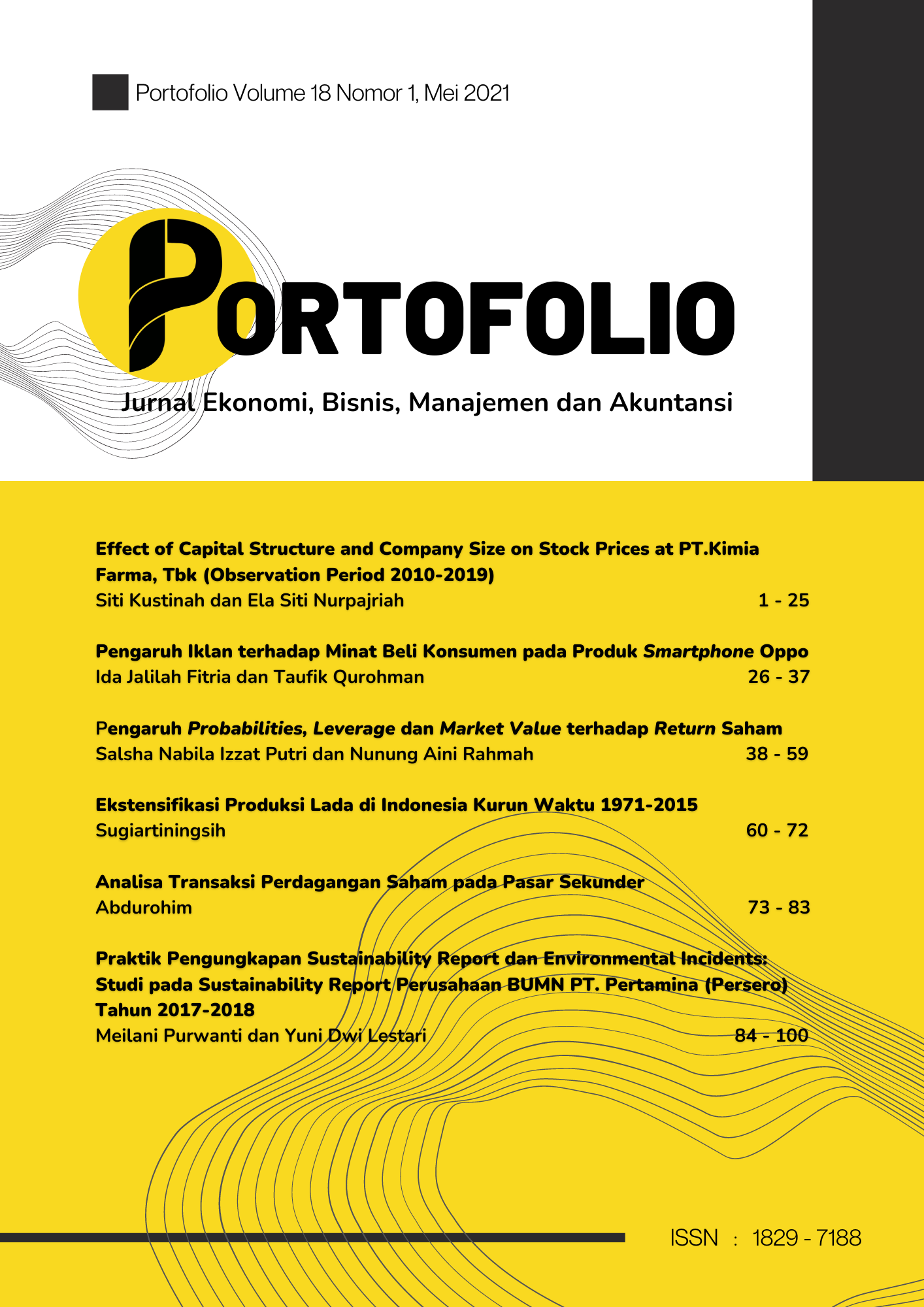Ekstensifikasi Produksi Lada di Indonesia Kurun Waktu 1971-2015
Abstract
Abstract
The success of the agricultural sector in Indonesia is highly dependent on the main production factor, namely land area. Pepper production as Indonesia's most important plantation crop to improve people's welfare cannot be separated from the influence of land use owned by farmers. The response of farmers to pepper plants is the main key to being able to take advantage of their land area to increase pepper production in Indonesia. The purpose of this study was to determine the extensification of pepper production in Indonesia in the period 1971-2015. The research model used is descriptive analysis using linear regression. From the calculation results, it is found that there is a unidirectional and significant relationship between land area and pepper production in Indonesia. This statement is in accordance with the production theory that increasing the area of land used for pepper cultivation will increase pepper production in Indonesia. According to the reality, Indonesia from a geographical point of view is the country with the largest land area in addition to the high selling value of pepper, especially in the international market. Thus, the response of farmers who are large enough to plant pepper has made pepper status as the main crop and ultimately increased pepper production in Indonesia and was able to increase the export value of plantation products.
Abstrak
Kesuksesan sektor pertanian di Indonesia sangat tergantung faktor produksi utama yaitu luas lahan. Produksi lada sebagai tanaman perkebunan terpenting Indonesia dalam upaya meningkatkan kesejahteraan rakyat tidak dapat dilepaskan dari pengaruh penggunaan lahan yang dimiliki petani. Respon petani terhadap tanaman lada menjadi kunci utama untuk dapat memnfaatkan luas lahan yang dimiliki untuk peningkatan produksi lada di Indonesia. Tujuan penelitian ini untuk mengetahui ekstensifikasi produksi lada di Indonesia kurun waktu 1971-2015. Model penelitian yang digunakan adalah analisis deskriptif dengan menggunakan regresi linier. Dari hasil perhitungan diperoleh hasil adanya hubungan searah dan signifikan antara luas lahan dengan produksi lada di Indonesia. Pernyataan tersebut sesuai dengan teori produksi bahwa peningkatan luas lahan yang digunakan untuk penanaman lada akan meningkatkan produksi lada di Indonesia. Sesuai realitas Indonesia dari sisi geografis merupakan negara pemilik luas lahan terbesar disamping juga nilai jual lada yang yang cukup tinggi terutama di pasar internasional. Dengan demikian respon petani yang cukup besar untuk menanam lada telah menjadikan status lada sebagai tanaman utama dan akhirnya meningkatkan produksi lada di Indonesia serta mampu meningkatkan nilai ekspor produk perkebunan.
References
Amirudin Syam, Efisiensi Produksi Komoditas Lada Di Propinsi Bangka Belitung, 4064-1-5976-1-10-20121129
Damodar N. Gujarati, Dawn C. Porter, Basic Econometrics Fifth Edition, Mc Graw-Hill: 2009.
Direktorat Jendral Bina Produksi Perkebunan, 2002-2003
Dominick Salvatore, Managerial Economics dalam Perekonomian Global Edisi Keempat Jilid 1, Penerbit Erlangga, Jakarta: 2002
Ekonomi Lada, Demam Lada Dipicu Harga, Tempo, Jakarta: 2-8 Januari 2017
http://ditjenbun.pertanian.go.id/tinymcpuk/gambar/file/statistik/2016/LADA%202014-2016.pdf
http://ejurnal.litbang.pertanian.go.id/index.php/jpengkajian/article/view/1507 (Dewi Sahara, Yusuf dan Suhardi, Pengaruh Faktor Produksi pada Usahatani Lada di Sulawesi Tenggara (Kasus Integrasi Lada Ternak di kecamatan Landono, Kabupaten Kendari), Jurnal Pengkajian dan Pengembangan Teknologi Pertanian Vol. 7 No. 2. Juli 2004: 139-145)
http://repository.ipb.ac.id/handle/123456789/60527 (Analisis Faktor-faktor yang Mempengaruhi Produksi Lada di Kabupaten Bangka Provinsi Kepulauan Bangka Belitung)
http://www.academia.edu/7153775/Makalah_lada (Makalah; BUDIDAYA TANAMAN REMPAH, OBAT DAN AROMATIKA “Tanaman Lada (Piper nigrum L.)”)
https://www.bps.go.id/linkTabelStatis/view/id/1670
Karl E. Case, Ray C. Fair, Prinsip Prinsip Ekonomi Jilid 1Edisi 8, Penerbit Erlangga, Jakarta: 2007
Paul A. Samuelson & William D. Nordhaus, Mikroekonomi Edisi Keempatbelas, Penerbit Erlangga, Jakarta: 1997
Ragam-Spice Story, Rempah Indonesia, Riwayatmu Kini, Komunita (Komunikasi Pendidikan Widyatama), Majalah Triwulan Edisi 18/Th-5/November 2016, Bandung: 2016
Robert S. Pindyck, Daniel L. Rubinfeld, Mikroekonomi Edisi Kedelapan, Penerbit Erlangga, Jakarta: 2012
Sadono Sukirno, Mikroekonomi Teori Pengantar Edisi Ketiga,PT Raja Grafindo Persada, Jakarta: 2012
Sugiartiningsih, Pengaruh Luas Lahan Terhadap Produksi Jagung Di Indonesia Periode 1990-2006,Jurnal Ekono-Insentif Jurnal Ilmiah Bidang Ilmu Ekonomi- Kopertis Wilayah IV Volume 6 No. 1, Juli 2012 ISSN. 1907-0640, Kopertis Wilayah IV Jawa Barat dan Banten: 2012
Yudi Sapta Pranoto, Faktor Yang mempengaruhi keputusan Petani Terhadap Hasil Panen Lada Putih di Kecamatan Simpang Teritip Kabupaten Bangka Barat, Jurnal Agraris Vol.2.No.1 Januari 2016, DOI: 10.18196/agr.2127 udhei-sapta@yahoo.com 1134-3257-2-PB
Authors who publish in Portfolio: Jurnal Ekonomi, Bisnis, Manajemen, dan Akuntansi agree to the following terms:
- Authors retain copyright and grant the journal right of first publication with the work simultaneously licensed under a Attribution-ShareAlike 4.0 International (CC BY-SA 4.0) License that allows others to share the work with an acknowledgment of the work's authorship and initial publication in this journal.
- Authors are able to enter into separate, additional contractual arrangements for the non-exclusive distribution of the journal's published version of the work (e.g., post it to an institutional repository or publish it in a book), with an acknowledgment of its initial publication in this journal.
- Authors are permitted and encouraged to post their work online (e.g., in institutional repositories or on their website) prior to and during the submission process, as it can lead to productive exchanges, as well as earlier and greater citation of published work (See The Effect of Open Access).


1.png)






